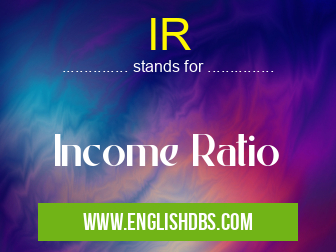What does IR mean in ACCOUNTING
Income Ratio or IR is a metric that measures the amount of income earned by a company in proportion to its expenses. It evaluates the profitability of a company and can be used as an indicator of how well a business is doing financially. IR calculations enable investors to identify companies that have strong potential for generating high returns on their investments. In addition, income ratio is used to compare companies within the same industry and measure how they fare against each other in terms of profitability.

IR meaning in Accounting in Business
IR mostly used in an acronym Accounting in Category Business that means Income Ratio
Shorthand: IR,
Full Form: Income Ratio
For more information of "Income Ratio", see the section below.
» Business » Accounting
Definition
Income Ratio (IR) is a financial analysis metric used to measure the relative profitability of a business. It is calculated by taking total income from operations or sales receipts minus related expenses and dividing it by total sales receipts generated while deducting any extraordinary items not associated with daily operations. This calculation gives investors information about how efficient a business is at generating profits after taking into account all of the costs incurred, such as overhead, taxes, wages, rent etc. The higher the ratio indicates that the company has better management practices and more efficiently run operations compared to others in its industry.
Uses
IR can be used in several ways by financial analysts and investors in order to make informed decisions regarding businesses and stocks. Firstly, it can help them determine whether a particular stock has potential for growth based on its current profitability level compared with other stocks in the same sector or industry. Secondly, IR can be helpful when evaluating the performance of multiple years of data to identify trends that may indicate future profitability levels or losses due to changes made either internally or externally by competitors. Thirdly, this metric can also be used as an indicator when comparing companies within the same industry since it shows which companies are most efficiently managed and producing higher incomes versus those producing lower incomes due to less efficient management practices or operational processes. Lastly, IR can help investors gauge future investment opportunities based on individual companies’ past performance since very often profitable firms will continue exhibiting positive trends going forward if left unobstructed by external volatility.
Essential Questions and Answers on Income Ratio in "BUSINESS»ACCOUNTING"
What is the Income Ratio?
The income ratio is a metric used to analyze one’s ability to pay back debts and manage financial resources. It is calculated by taking the total amount of money earned in a year (or other period) and dividing it by the total debt owed. This produces a ratio that indicates how much of their income goes towards paying off debts.
How do lenders use the Income Ratio?
Lenders use an individual’s income ratio as part of a credit assessment to evaluate their ability to repay loans. A low income ratio means there may be insufficient funds available to cover debt payments, increasing potential risk for lenders.
What is a good Income Ratio?
Generally, lenders prefer borrowers who have an income ratio below 35%. This indicates that these individuals have sufficient funds available for loan repayments after accounting for other financial obligations such as bills and living expenses.
Is it possible to improve your Income Ratio?
Yes, there are several steps you can take to improve your income ratio including reducing your debt or increasing your income. Paying down debt quickly can help lower your overall debt burden and also free up more money for other needs such as savings goals or emergency expenses. Additionally, earning additional sources of income through side hustles or part-time work can increase disposable income and reduce borrowing costs over time.
How does Debt-Income Ratio differ from Loan-to-Value Ratio?
While both ratios are used in assessing potential creditworthiness, they measure different factors related to borrowing capacity. Loan-to-value (LTV) looks at the relationship between the size of a loan and its collateral value while Debt-Income Ratios focuses on one’s personal financial resources versus their total debt burden. In short, LTV measures the relationship between what’s borrowed against what’s owned, while Debt-IncomeRatio assesses one’s ability to repay loans based on current fiscal health.
Is my Debt-Income Ratio impacted if I am married?
Yes, marriage could impact one's Debt-Income Ratio as both parties' financial activity will now be combined into one analysis metric when evaluating creditworthiness; not just individual components like salary or rent/mortgage payment history. As such, couples may need to adjust their spending habits accordingly before applying for joint accounts or mortgages.
Does having multiple bank accounts affect my Debt-Income Ratio?
Not necessarily; having multiple bank accounts will not directly affect one's Debt-Income Ratio unless you are utilizing them to take out additional loans or accrue more debt than you can realistically afford on whatever separate or joint accounts you may have open already.
What other metrics are commonly used alongside Debt-Income Ratios when evaluating my credit score?
Other metrics commonly used alongside Income Ratios include Credit Utilization Rate (how much available credit you're using relative to total available) and Payment History (how consistently & punctually you've paid back past debts). Collectively these factors serve as indicators of your overall fiscal responsibility.
Final Words:
In summary, Income Ratio (IR) is an important metric for assessing businesses’ overall financial stability and growth potential because it reveals how much profit each company makes from its operations after taking into account expenses related to running day-to-day activities like salaries, rent etc., as well as non-recurring items like taxes or litigation costs. It also compares similarly situated firms so that investors can identify potentially lucrative prospects with greater confidence based on their past performances and future outlooks.
IR also stands for: |
|
| All stands for IR |
